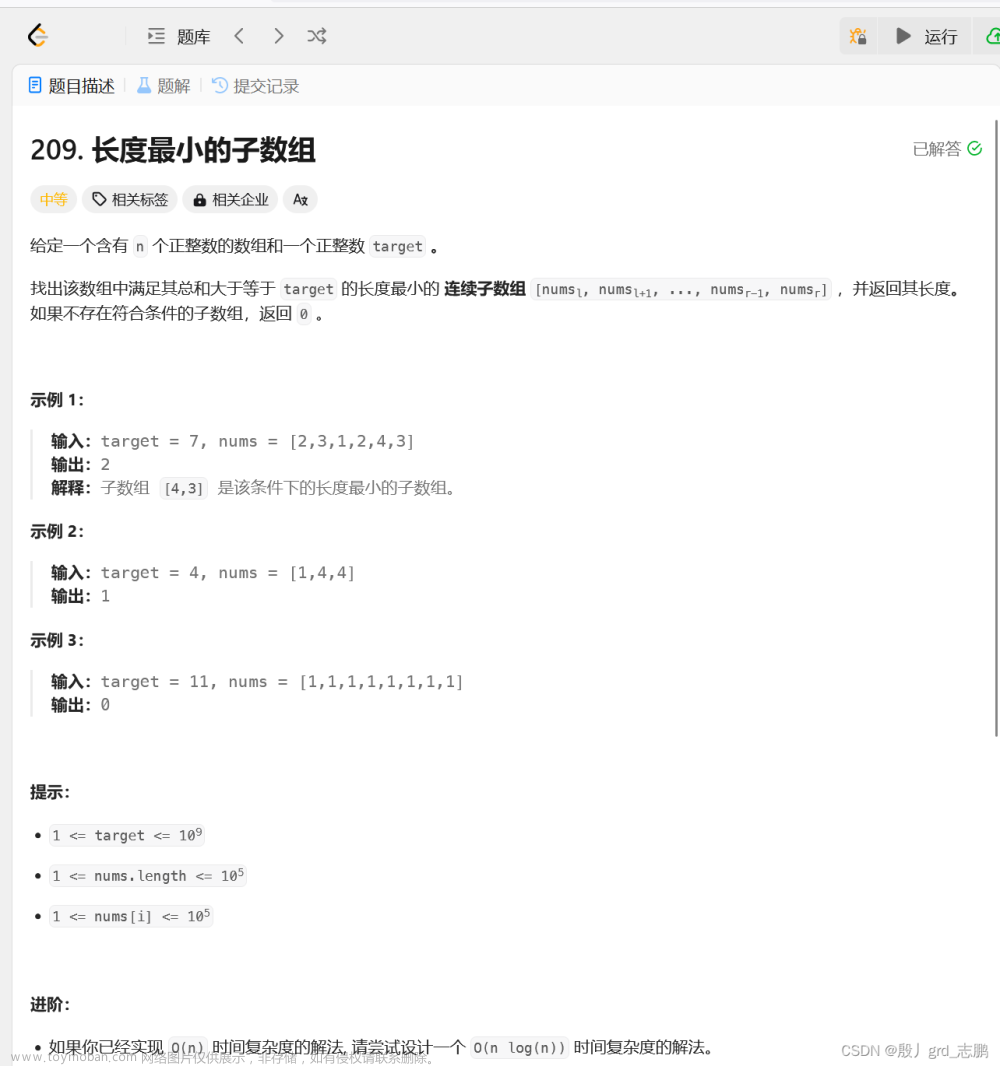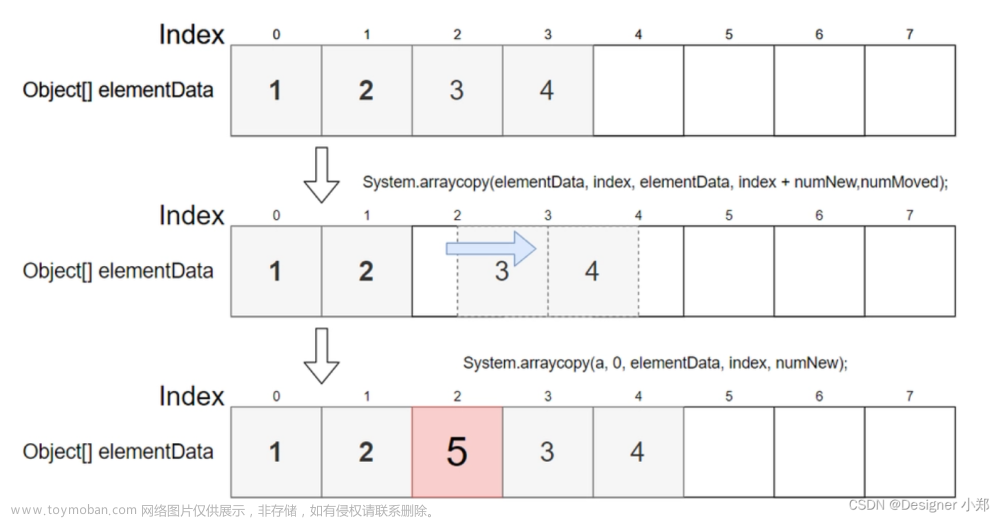一、数据结构
- 是一门基础学科
- 研究的是数据如何在计算机中进行组织和存储,使得我们可以高效的获取数据和修改数据
- 数据结构可以分为三类: 线性结构: 数组、队列、栈、链表、哈希表… 树型结构:二叉树、二分搜索树、AVL树,红黑树、堆、Trie、线段树、并查集… 图结构:邻接矩阵、邻接表 排序算法
- 为什么学习数据结构: 根据不同的应用,灵活选择最合适的数据结构
数据结构 + 算法 = 程序
二、数组
1、数组基础
- 用来存储一组类型相同的数据
- 在内存中,分配连续的空间,数组创建时要指定容量(大小)
- 数据类型[] 数组名 int[] arr = new int[10] int[] arr2 = {1,2,3,4}
- 索引---访问数组时通过索引进行操作
- 索引从0开始,最大为 arr.length -1
- 常见的错误: NullPointException和ArrayIndexOutOfBoundsException
- 常见的数组: 字符串, 对象数组,哈希表
2.Java中数组的特点
(1)数组在内存中连续分配;
(2)创建数组时要指明数组的大小;
(3)可以通过索引进行访问,索引从0开始,这里索引可以理解为偏移量;
(4)使用索引:
- 获取指定索引位置的值——arr[index]
- 修改指定索引位置的值——arr[inedx]
- 删除数组中元素(假删除)
(5)数组的遍历:将数组中元素打印出来;
(6)数组创建好之后,大小不能改变。
3.演示数组的使用
import java.util.Arrays;
import java.util.Comparator;
public class ArrayDome {
public static void main(String[] args) {
//练习数组的相关知识
//1.定义数组
int[] ints = new int[]{1,1,4,5,1,4};
//获取数组长度
int length = ints.length;
//获取指定元素位置
int num = ints[2];
System.out.println(num);
//修改元素
ints[2] =100;
num = ints[2];
System.out.println(num);
//遍历数组
for(int i= 0;i < ints.length;i++){
System.out.print(ints[i]+"\t");
}
System.out.println();
//数组越界错误
try{
System.out.println(ints[length]);
}catch (Exception e){
e.printStackTrace();
}
//数组为空错误
String[] strings = null;
try{
System.out.println(strings);
length = strings.length;
}catch (Exception e){
e.printStackTrace();
}
//数组的排序
Arrays.sort(ints);
for(int i= 0;i < ints.length;i++){
System.out.print(ints[i]+"\t");
}
System.out.println();
}
}
输出结果:
 文章来源:https://www.toymoban.com/news/detail-803729.html
文章来源:https://www.toymoban.com/news/detail-803729.html
4.制作自己的数组
package leetcoke;
import java.util.Arrays;
import java.util.Comparator;
public class MyArray<T> {
private T[] data;
private int length;
private int size;
//构造方法
public MyArray(int size) {
if (size <= 0) {
this.size = 16;
} else {
this.size = size;
}
this.length = 0;
this.data = (T[]) new Object[this.size];
}
//获得当前的数组容量
public int getSize() {
return this.size;
}
//判断是否为空
public boolean isEmpty() {
return this.length == 0;
}
//添加
public void add(T data) throws IllegalAccessException {
add(this.length,data);
}
//在指定位置添加
public void add(int index, T data) throws IllegalAccessException {
if (index < 0 || index > this.length) {
throw new IllegalAccessException("你看你传的是个啥!");
}
//判断数组已满
if(this.size==this.length){
//扩容
resize(this.size*2);
}
for (int i = this.length; i > index; i--) {
this.data[i] = this.data[i - 1];
}
this.data[index] = data;
this.length++;
}
//扩容
private void resize(int newCapacity){
T[] newData = (T[]) new Object[newCapacity];
newData = Arrays.copyOf(this.data,newCapacity);
this.data = newData;
this.size = newCapacity;
}
//修改指定位置的值
public void modifyValueByIndex(int index, T value) throws IllegalAccessException {
//入参判断
if (index < 0 || index >= this.size) {
throw new IllegalAccessException("你看你传的是个啥!");
}
this.data[index] = value;
}
//获取位置上的值
public T getValueByIndex(int index) throws IllegalAccessException {
//入参判断
if (index < 0 || index >= this.size) {
throw new IllegalAccessException("你看你传的是个啥!");
}
return this.data[index];
}
//查询
public int containsValue(T val) {
int i;
for (i = this.length - 1; i >= 0; i--) {
if (this.data[i] == val) {
return i;
}
}
return i;
}
//根据索引删除
public T removeByIndex(int index) throws IllegalAccessException {
//入参判断
if (this.length == 0) throw new IllegalAccessException("已经一点都不剩下了!");
if (index < 0 || index >= this.size) {
throw new IllegalAccessException("你看你传的是个啥!");
}
T res = this.data[index];
for (int i = index + 1; i < this.length; i++) {
this.data[i - 1] = this.data[i];
}
this.length--;
if(this.length<=this.size/3 && this.size/2!=0){
resize(this.size/2);
}
return res;
}
@Override
public String toString() {
StringBuffer buffer = new StringBuffer("[");
for (int i = 0; i < this.length; i++) {
buffer.append(this.data[i]);
if (i != this.length - 1) {
buffer.append(",");
}
}
buffer.append("]");
return buffer.toString();
}
//排序
private T[] toArray1() {
return Arrays.copyOf(data, length);
}
public void sort() {
T[] array = toArray1();
Arrays.sort(array, new Comparator<T>() {
@Override
public int compare(T o1, T o2) {
if ((o1 instanceof Integer) || (o1 instanceof Float) || (o1 instanceof Double) || (o1 instanceof Short) || (o1 instanceof Long) || (o1 instanceof Byte)) {
return (Integer) o1 - (Integer) o2;
}
return 0;
}
});
for(int i = 0;i < this.length;i++){
this.data[i] = array[i];
}
}
public static void main(String[] args) throws IllegalAccessException {
MyArray<Integer> array = new MyArray<>(5);
//输入数组的值
for (int i = 0; i < 5; i++) {
array.add((int) (Math.random() * 100 % 11));
}
try {
System.out.println(array.getSize());
array.add(3, 8);
} catch (Exception e) {
e.printStackTrace();
}
//排序
array.sort();
//遍历
System.out.println(array);
//查询
try {
System.out.println(array.getValueByIndex(2));
//找索引
System.out.println("8在数组中的位置为:" + array.containsValue(8));
} catch (Exception e) {
e.printStackTrace();
}
//删除值
try {
System.out.println(array.removeByIndex(array.containsValue(8)));
} catch (Exception e) {
e.printStackTrace();
}
//删除索引的位置
try {
System.out.println(array.removeByIndex(3));
} catch (Exception e) {
e.printStackTrace();
}
//向数组中指定位置添加元素
try {
System.out.println(array.getSize());
array.add(3, 8);
} catch (Exception e) {
e.printStackTrace();
}
System.out.println(array);
coke coke1 = new coke("coke", 18);
coke coke2 = new coke("coke", 20);
MyArray<coke> cokeMyArray = new MyArray<>(0);
cokeMyArray.add(coke1);
cokeMyArray.add(coke2);
System.out.println(cokeMyArray);
}
}
文章来源地址https://www.toymoban.com/news/detail-803729.html
到了这里,关于数据结构Java版(1)——数组的文章就介绍完了。如果您还想了解更多内容,请在右上角搜索TOY模板网以前的文章或继续浏览下面的相关文章,希望大家以后多多支持TOY模板网!












